Kleptomania symptoms and treatment
Table of content
- What are the symptoms of Kleptomania?
- 1. Inability to resist powerful urges to steal items that you don’t need
- 2. Feeling increased tension, anxiety, or arousal leading up to the theft
- 3. Feeling pleasure, relief, or gratification while stealing
- 4. Feeling terrible guilt, remorse, self-loathing, shame, or fear of arrest after the theft
- 5. Return of the urges and repetition of the kleptomania cycle
- What are the causes of Kleptomania?
- What are the recommended treatments for Kleptomania?
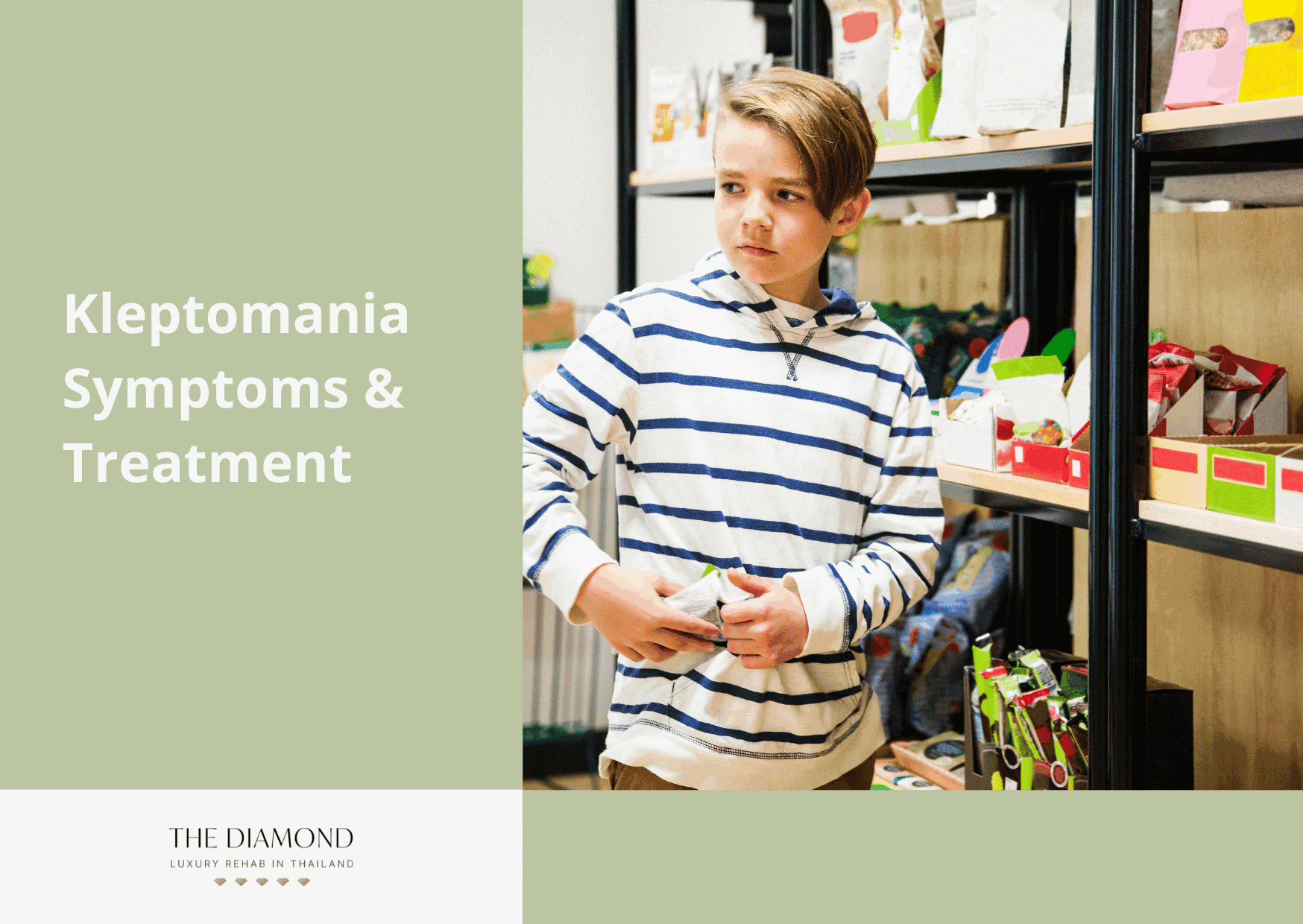
Kleptomania is an impulse control disorder characterized by recurrent urges to steal. A patient with kleptomania is unable to control these urges or impulses. Stealing isn’t something a patient with kleptomania plans, but they’re not able to ignore the craving.
Symptoms of kleptomania include the inability to resist powerful urges to steal items that you don’t need, feeling increased tension, anxiety, or arousal leading up to the theft, feeling pleasure, relief, or gratification while stealing, feeling terrible guilt, remorse, self-loathing, shame, or fear of arrest after the theft, and a return of the urges and a repetition of the kleptomania cycle.
The treatment options for kleptomania include medications, psychotherapy, and relapse prevention.
What are the symptoms of Kleptomania?
Symptoms of kleptomania refer to the observable signs and behaviors frequently seen in individuals affected by the condition. The symptoms of kleptomania are listed below.
- Inability to resist powerful urges to steal items that you don’t need
- Feeling increased tension, anxiety, or arousal leading up to the theft
- Feeling pleasure, relief, or gratification while stealing
- Feeling terrible guilt, remorse, self-loathing, shame, or fear of arrest after the theft
- Return of the urges and a repetition of the kleptomania cycle
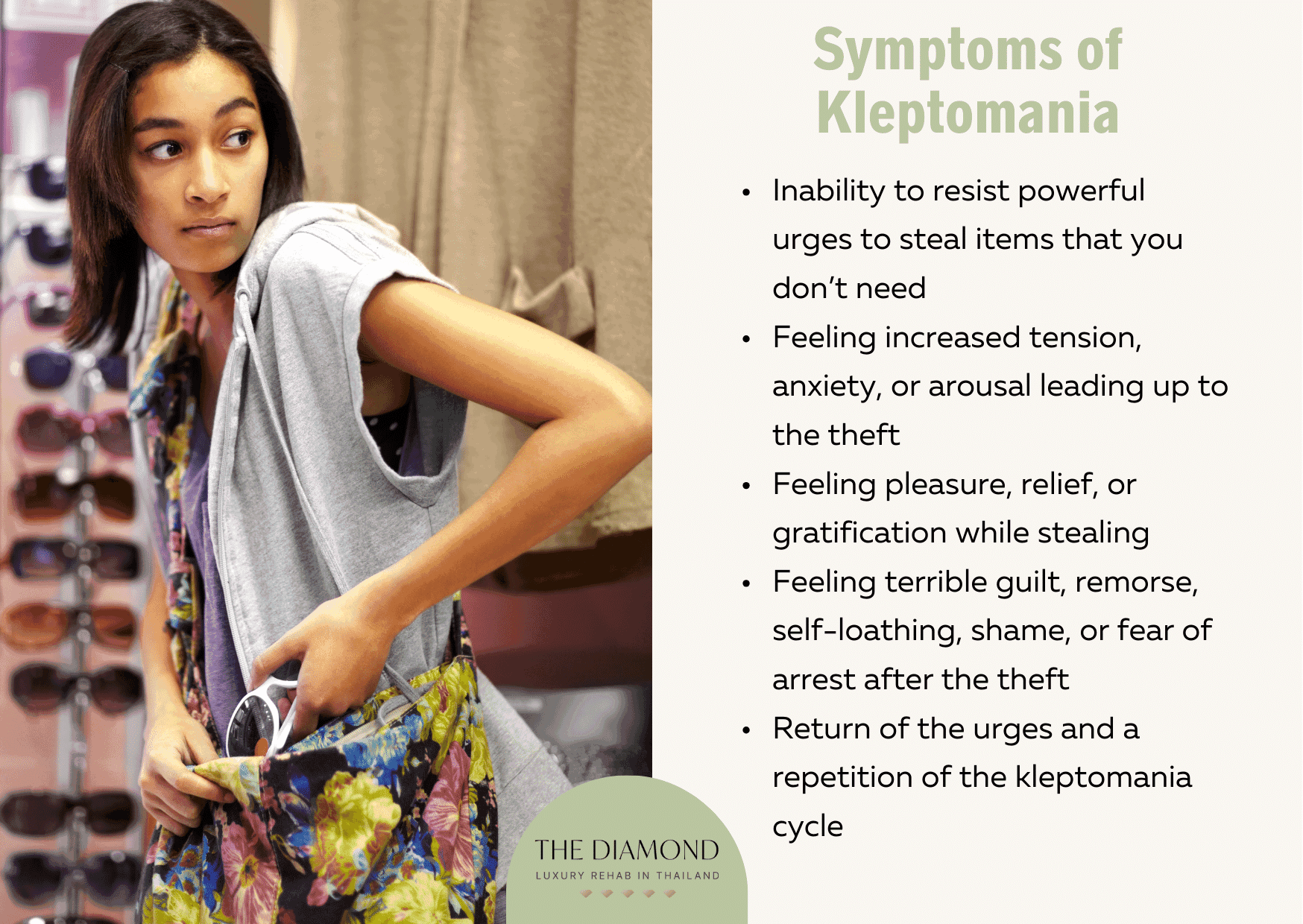
1. Inability to resist powerful urges to steal items that you don’t need
The inability to resist powerful urges to steal items that one doesn’t need is a defining symptom of kleptomania that is characterized by the recurrent failure to resist the impulse to steal items. Individuals with kleptomania experience intense and irresistible urges to take items, even if they have little or no personal value, and often when they don’t need the items.
A kleptomaniac experiences strong urges or cravings for stealing. These cravings or impulses are like those that people with drug addiction experience before using drugs. In fact, kleptomania has elements associated with addiction. An individual with kleptomania usually has cravings to steal something they don’t need.
They don’t plan to steal anything, nor do they want to steal stuff that they use or get other benefits from them. Instead, patients with this condition have a compulsive need to take something they don’t even like, need, or want. It’s useful to remember that kleptomania is an impulse control disorder, meaning a person isn’t able to control or ignore the compulsive urges to steal. A person with kleptomania knows what they’re doing is wrong, but they are unable to help it.
2. Feeling increased tension, anxiety, or arousal leading up to the theft
Feeling increased tension, anxiety, or arousal leading up to the theft is a symptom where people who struggle with kleptomania often experience a build-up of tension and anxiety before committing the theft. This heightened emotional state is a crucial component of the disorder, as the act of stealing is driven by an intense urge to relieve this tension.
A powerful urge to steal something is often accompanied by intense tension or even arousal and anxiety before a person takes the object, product, or other item. Various people with kleptomania are aroused by the act of theft.
They feel excitement or even nervousness before they act on the impulse and take something. Heightened tension and arousal make the urge to steal even stronger.
3. Feeling pleasure, relief, or gratification while stealing
Feeling pleasure, relief, or gratification while stealing means that individuals with kleptomania experience these emotional responses during or after the act of stealing. However, the pleasure or gratification derived from the theft is often temporary, and they subsequently experience guilt, remorse, or shame about their actions.
In a person with kleptomania, the act of stealing causes the release of dopamine. Neurotransmitter dopamine influences moods, feelings, rewards, and motivation.
Since stealing increases dopamine levels, patients with kleptomania experience pleasure and relief or gratification while they’re stealing something. This is the reaction to acting on the urge to steal and nervousness that occurred before.
Dopamine produces pleasurable feelings. For that reason, an affected individual wants to experience them again. This aggravates the condition and makes someone steal more and more.
4. Feeling terrible guilt, remorse, self-loathing, shame, or fear of arrest after the theft
Feeling terrible guilt, remorse, self-loathing, shame, or fear of arrest after the theft describes the profound emotional aftermath individuals experience following the act of theft. Despite the momentary pleasure or relief during the stealing episode, those with kleptomania commonly encounter intense negative emotions, including guilt, remorse, self-loathing, and shame.
That happens because they are aware stealing is wrong. Most patients don’t want or plan to steal. However, the urge to steal is too strong, and they are unable to resist it. For that reason, it’s not uncommon for people to feel disappointed with themselves or be afraid of getting caught or arrested. This is the point when someone with kleptomania usually decides they will never steal something again.
5. Return of the urges and repetition of the kleptomania cycle
A return of the urges and repetition of the kleptomania cycle refers to a characteristic pattern observed in individuals with kleptomania. After the act of stealing, individuals often experience a temporary sense of relief or gratification. However, this relief is short-lived, as the urges to steal return, marking the repetition of the kleptomania cycle.
Kleptomania is a condition with the recurrent act of stealing. That means when a person steals something, it’s not a one-time thing. Instead, they have the urge to do it again. Keep in mind that a patient with kleptomania doesn’t have the urge to steal daily.These impulses appear again after a certain amount of time. The scariest thing about kleptomania is that compulsive impulses to steal show up suddenly. Sometimes they are a response to stress or other stimuli.

What are the causes of Kleptomania?
The causes of kleptomania include genetics, neurotransmitter abnormalities, and existing psychiatric disorders.
Kleptomania, like other impulse control disorders, is prevalent in families. In fact, a 2013 paper by Laura Bevilacqua and David Goldman published in the Philosophical Transactions of the Royal Society of London shows several genes are linked to impulsivity. The paper explained that impulsivity is a heritable trait as well.
Although a lot more research on this subject is necessary, current evidence shows that certain people are likely to have a genetic predisposition to impulse control disorders, including kleptomania.
As mentioned above, genetics isn’t the sole cause of kleptomania. Neurotransmitter abnormalities play a major role in the development of this disorder. Kleptomania is associated with changes in levels of chemical messengers in the brain, such as serotonin and dopamine.
The main role belongs to serotonin, a neurotransmitter that regulates mood and emotions. Low levels of this neurotransmitter contribute to the development of kleptomania.
The imbalance of neurotransmitters changes the way people react to various situations. Besides serotonin, dopamine is another brain chemical involved in kleptomania development. In a kleptomaniac, stealing triggers the release of dopamine and generates pleasant feelings.
Dopamine is involved in the brain’s reward system as well. For that reason, a person continues to steal in order to experience those feelings again, and their behavior becomes compulsive.
Existing mental health disorders are psychological reasons for stealing and they play a role in the development and progression of kleptomania. For instance, there is a significant rate of general comorbidity among patients with Kleptomania, as seen by the high rates of other impulse control disorders (51.6%), mood disorders (45.2%), anxiety disorders (32.3%), substance use disorders (29%), and OCD (6.5–60%), as per pages 61-68 of the book, “Encyclopedia of Mental Health (Second Edition)” published in 2016 by the Academic Press.A combination of several causes is highly likely to pave the way for kleptomania. For example, genetics and low serotonin levels are both significant kleptomania causes. So, the changes in those genes possibly change the way people control or react to various stimuli and impulses.
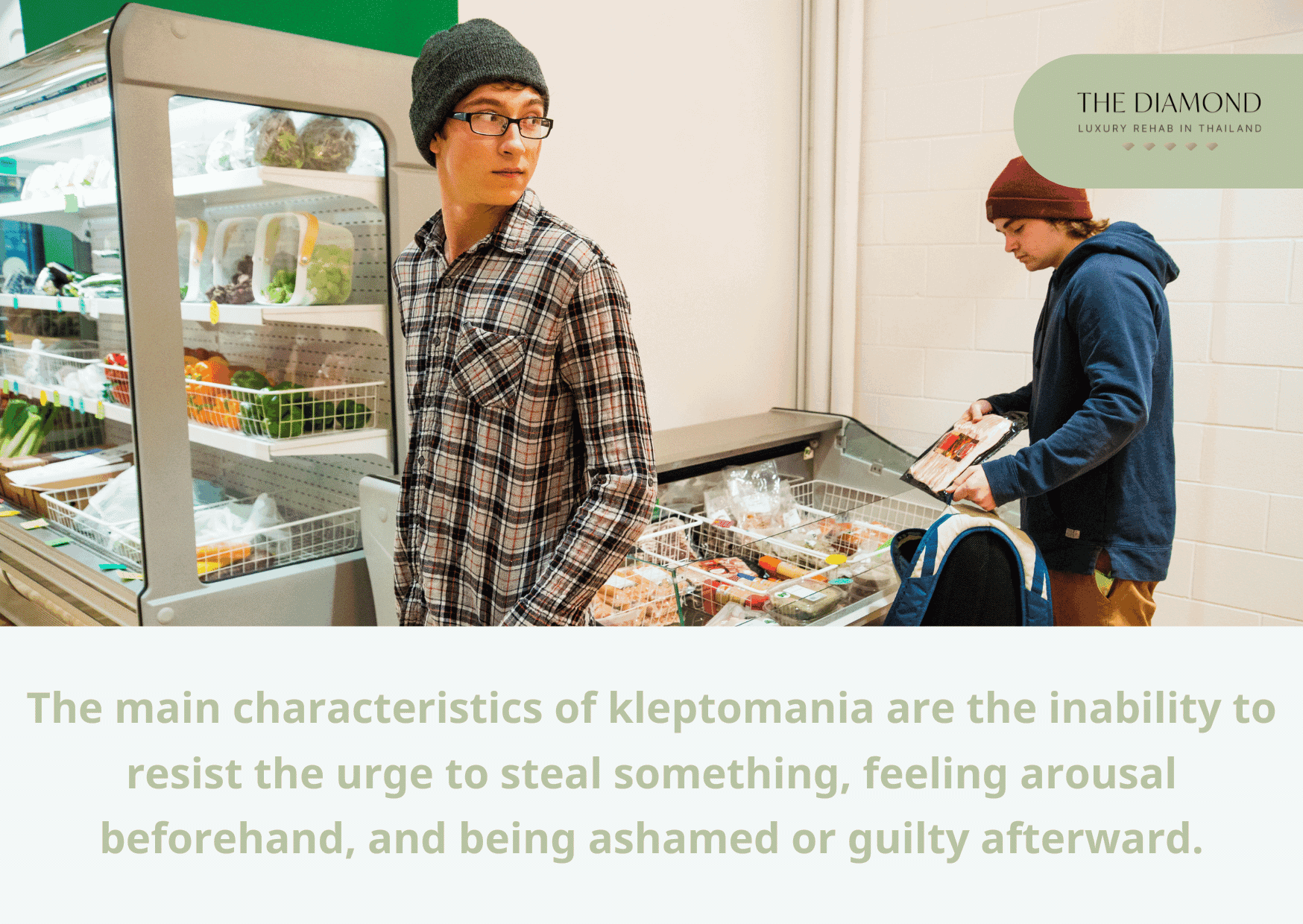
What are the characteristics of Kleptomania?
The main characteristics of kleptomania are the inability to resist the urge to steal something, feeling arousal beforehand, and being ashamed or guilty afterward. Kleptomania usually starts in adolescence or early adulthood, but certain people develop it later in life too. Around two-thirds of kleptomania patients are women.
Not all cases of kleptomania are the same. Different types of kleptomania include sporadic kleptomania with brief episodes and long remission periods, episodic kleptomania with protracted stealing periods followed by remission periods, and chronic kleptomania with fluctuation periods.Kleptomania is identified by the fact that the focus is not on the stolen object. Instead, the main emphasis is on the compulsion to steal and the lack of self-control to stop it. A person with kleptomania hoards things they steal, give them away, or even return them.
What are the risk factors of Kleptomania?
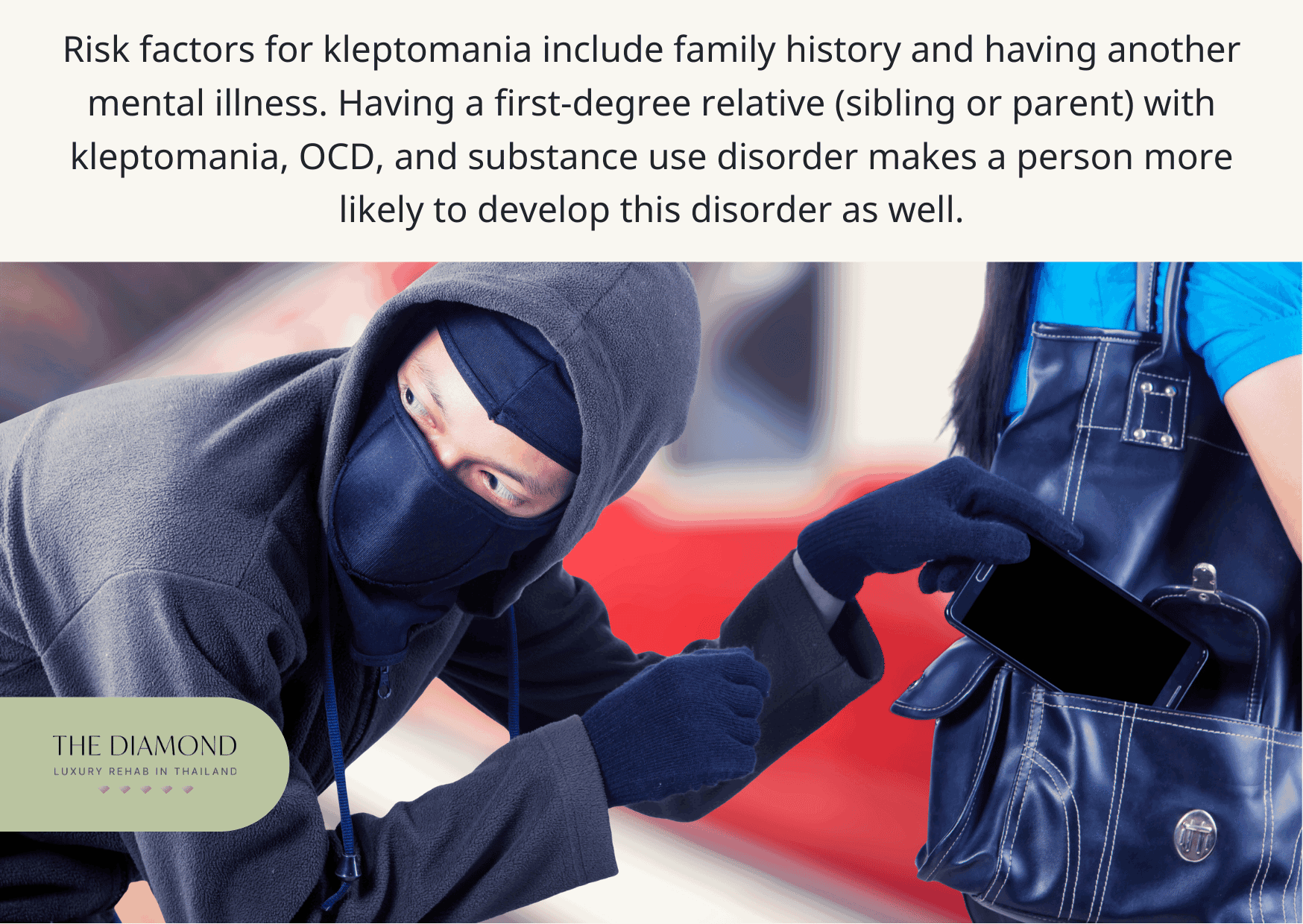
Risk factors for kleptomania include family history and having another mental illness. Having a first-degree relative (sibling or parent) with kleptomania, OCD, and substance use disorder makes a person more likely to develop this disorder as well.
Most people with stealing addiction have other mental illnesses such as anxiety, bipolar disorder, substance use disorder, and personality disorder. In other words, the presence of other mental health problems increases the risk of developing kleptomania too.
Besides family history and the presence of other mental illnesses, there are other factors that contribute to kleptomania. These include low serotonin levels, head trauma such as concussion, imbalance in the brain’s opioid system, and being a female. An article titled, “Stealing” last updated in 2017 on Healthline reported that two-thirds of patients with kleptomania are women.
Innovations in Clinical Neuroscience published a paper by Farid Ramzi Talih in its October 2011 issue that described a case of a 54-year-old woman with kleptomania whose condition was exacerbated by multiple factors. The patient had a history of addiction, psychological and childhood trauma, head trauma (concussion), and depression.
These findings confirm that various risk factors influence the development of this disorder, which is why scientists emphasize the importance of screening patients with a history of trauma, head trauma, and substance use disorders for kleptomania.
When should a Kleptomaniac seek advice from a doctor?
A person with kleptomania should seek advice from a doctor when they find it impossible to stop stealing. People with kleptomania disorder often want to stop stealing, but the craving or temptation is too strong.
At the same time, they’re reluctant to seek professional help because they’re afraid of getting arrested. A healthcare professional typically doesn’t report this behavior to authorities. It is useful to mention that certain people see a healthcare professional specifically to avoid getting in trouble later. Others are legally required to seek professional help e.g. after being arrested.
Friends and family of people with kleptomania must advise them to see a doctor when they notice signs of problematic or compulsive behavior.
Factors that determine the timing of development and progression of kleptomania are environmental influences such as stress, the severity of the underlying mental health condition, and triggers that contribute to this behavior.
It is of huge importance for a person with kleptomania to see the doctor as soon as compulsive stealing begins. That way, they receive adequate treatment and prevent or reduce the risk of complications associated with kleptomania.
What are the recommended treatments for Kleptomania?

The recommended treatments for kleptomania are often tailored to the individual’s specific needs and involve a multidisciplinary approach for effective management of the condition. The recommended treatments for kleptomania are listed below.
- Medications
- Psychotherapy
- Avoiding relapse
In most cases, a combination of different treatment approaches works best.
Treatment for kleptomania is effective through a well-structured program that addresses the unique needs of each patient. Self-help groups play an important role in the treatment of kleptomania as well.
Numerous people attempt to manage kleptomania on their own because they are afraid or embarrassed to get help. However, this disorder is difficult to overcome without professional help. A person with kleptomania needs a strong support system and encouragement to get help, without feeling like they’re being judged or criticized.
Kleptomania treatment is provided in an inpatient or outpatient setting. An inpatient program requires a patient to live in the treatment facility for a specific period of time e.g. 30, 60, or 90 days.
On the flip side, outpatient treatment includes regular sessions that patients attend, but they get to go home and maintain professional life during this time. The outpatient program is suitable for patients with milder kleptomania symptoms and those who have completed an inpatient treatment, which is necessary for people with severe kleptomania.
The possible cost of kleptomania treatment varies, as various factors such as location are involved. The average cost of outpatient treatment is $100 to $150 per session. The costs of inpatient treatments go from $7500 up to $100,000 a month.
In certain cases, health insurance covers the costs of the kleptomania treatment partially or in their entirety. Before choosing the treatment center or a therapist, it’s practical to check whether they accept the patient’s health insurance.
In cases of sliding scale, fees are available. A sliding scale means the costs of the treatment are adjusted according to the patient’s income.
Further below, treatment options for kleptomania are discussed in greater detail.
1. Medications

Medications are pharmacological interventions that help manage and alleviate symptoms associated with this impulse control disorder. Even though there is no medication created specifically for the treatment of kleptomania, healthcare professionals prescribe several options to manage the patient’s symptoms.
Doctors prescribe medications based on the patient’s situation, the severity of kleptomania, and the presence of other mental health problems. Medications that are prescribed for the management of addiction to stealing include antidepressants such as selective serotonin reuptake inhibitors (SSRIs), opioid antagonists such as naltrexone, and other medications or more of them.
The most commonly prescribed medications for kleptomania are SSRIs. A study by Lepkifker et al., titled, “The treatment of kleptomania with serotonin reuptake inhibitors” published in Clinical Neuropharmacology stated that these antidepressants are an effective treatment for kleptomania and other obsessive-compulsive spectrum disorders. What makes SSRIs effective is their potential to increase levels of serotonin by blocking the reabsorption (reuptake) of serotonin into neurons.
Besides SSRIs, naltrexone shows positive effects on the treatment of kleptomania. A 2009 study by Grant et al., published in Biological Psychiatry confirmed naltrexone exhibited statistically substantial reductions in both the urges and actions associated with kleptomania. Plus, the medication was well-tolerated.The prices of medications are not the same everywhere. The costs of oral naltrexone go from $25 to $60 a month. On the other hand, costs of SSRIs like Lexapro vary from one pharmacy to another and whether a patient has insurance or not. Certain pharmacies charge $105 for a 30-day supply.
2. Psychotherapy

Psychotherapy is an extensively employed and foundational therapeutic approach for kleptomania. This therapy technique entails having controlled, encouraging conversations with a mental health professional—such as a psychologist or psychiatrist—with individuals who suffer from kleptomania.
Psychotherapy helps patients overcome kleptomania and control the urges to steal by improving the way they react to stimuli or correcting their negative behaviors and thoughts. The most common type of psychotherapy for kleptomania and other impulse control disorders is cognitive-behavioral therapy (CBT).
Through CBT, patients learn to identify unhealthy and negative behaviors and beliefs in order to replace them with positive ones. The therapist uses different CBT methods to help patients overcome kleptomania. These include aversion therapy, covert sensitization, and systematic desensitization.
In aversion therapy, patients practice mildly painful techniques to control their urge to steal. For example, affected individuals hold their breath until they become uncomfortable whenever they are tempted to steal something.
Covert sensitization involves picturing oneself stealing and facing negative consequences afterward, whereas systematic desensitization is about practicing relaxation techniques and picturing oneself controlling the cravings for stealing.
Cognitive-behavioral therapy is particularly effective in combination with medications such as naltrexone. Besides individual therapy sessions, patients benefit from group therapy, family counseling, and couple’s counseling. The costs of therapy range from $100 to $200 or more per session, depending on the state.
3. Avoiding relapses
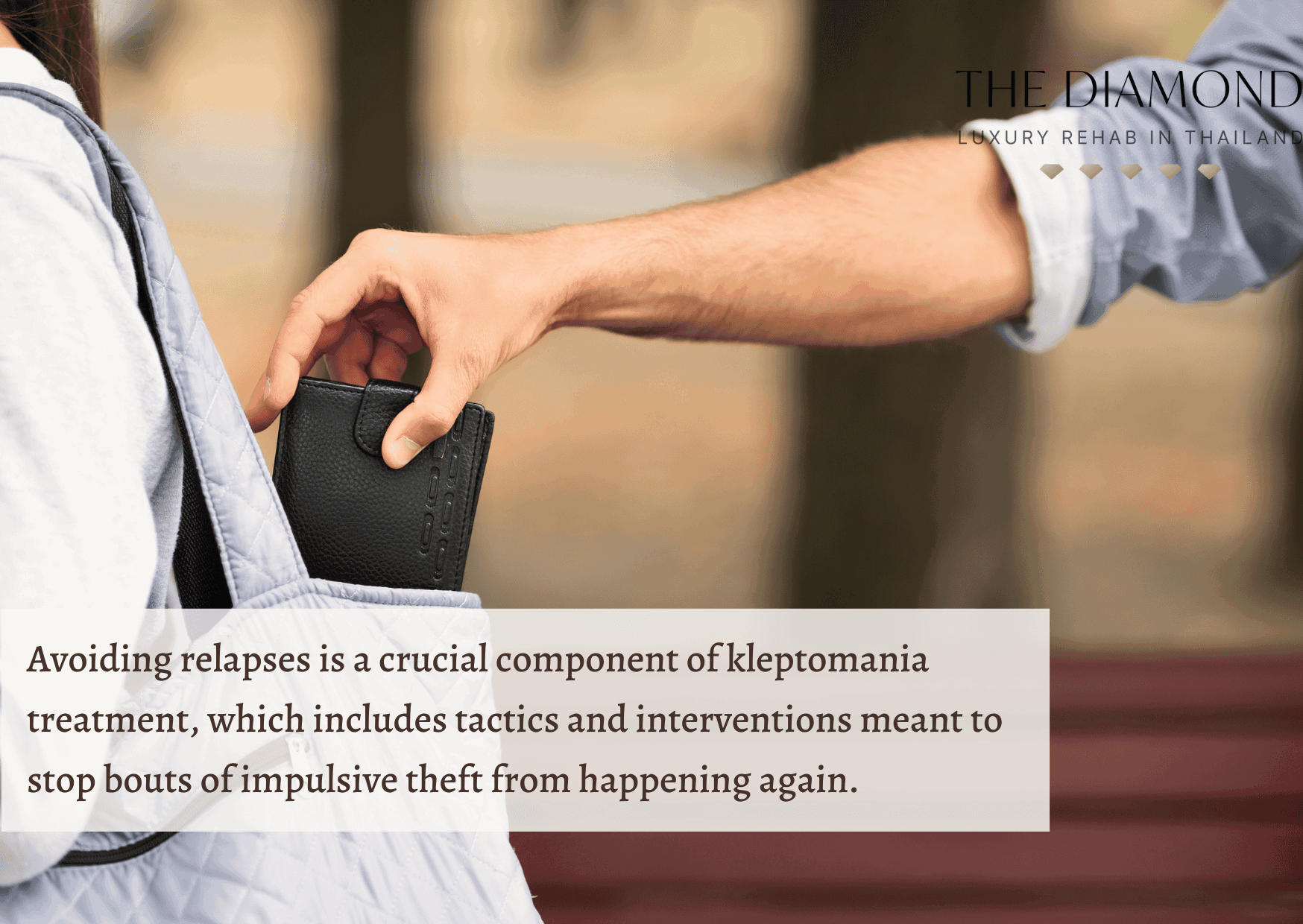
Avoiding relapses is a crucial component of kleptomania treatment, which includes tactics and interventions meant to stop bouts of impulsive theft from happening again. Relapses in the context of kleptomania are defined as the resurgence of cravings and the recurrence of the stressful, thieving, and emotionally charged cycle.
A great deal of kleptomania treatment focuses on avoiding relapse i.e. decreasing the risk of stealing again. The best way to avoid relapse is to stick to the treatment plan. Patients who feel the urge to steal must call their therapist or a doctor. Another way is to reach out to their support group or family and friends.
That way, they receive much-needed support and guidance to overcome the urge to steal something. Support groups are important for avoiding relapse. People with kleptomania share their experiences and support one another through recovery and relapse prevention.
Does kleptomania refer to stealing?
Yes, kleptomania refers to stealing. However, it’s worth noting that not every stealing is necessarily kleptomania. Ordinary theft is deliberate and motivated by the monetary worth or usefulness of the object. In this case, a person plans to steal something in order to gain financial or other kinds of benefits. Stealing usually occurs in the form of shoplifting.
Kleptomania doesn’t work that way, though. A person with kleptomania steals impulsively since they’re unable to control or resist the urge to take something. They aren’t motivated by monetary worth or usefulness.
In fact, people with kleptomania tend to take things they don’t even need. The main goal in kleptomania is to satisfy the temptation to steal, not to achieve a specific advantage. More precisely, while all people with kleptomania steal or take things, not everyone who steals has kleptomania. An important thing to bear in mind is that kleptomania is a psychological disorder whereas shoplifting usually starts as bad judgment. In certain cases, stealing creates a rush and excitement that people want to experience again, which is why they repeat the action. With time, it leads to addictive and compulsive shoplifting and kleptomania.

